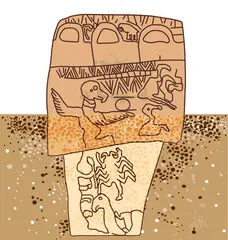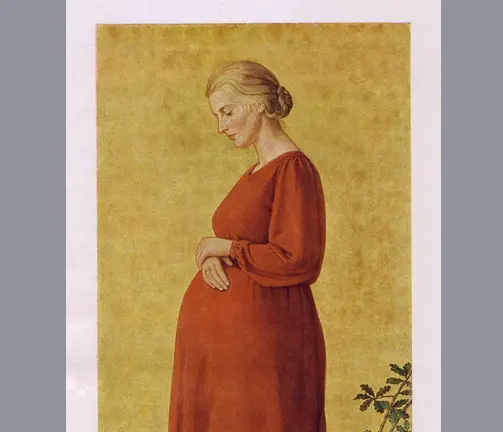Does the Gobekli Tepe Archeological Site Offer A Relevant Message for Our Time?
THE SIGNIFICANCE OF GOBEKLI TEPE, an article by Martin T.
The late William Luther Pierce once made a comment that seemed quite fanciful to many people. Pierce, who is commonly regarded as one of the deans of American White nationalism, once opined that humanity reached its collective high-point around 10,000 B.C.E. However, recent decades have produced archeological finds suggesting that Pierce might be correct.

In particular, the sites of Gobekli Tepe and Karahan Tepe, which are located in what is today called the nation of Turkey, have been drawing attention for many years now. Both of these high-profile archeological sites are located in Turkey’s Anatolia region, and both of these locations have set the stage for startling conclusions to emerge. Gobekli Tepe was first excavated by Klaus Schmidt in 1995, and excavation work began at Karahan Tepe in 2000. As of today, neither dig is complete and the latter excavation project is even further from completion. Both of these digs have unearthed a number of circular enclosures that include T-shaped stone pillars which weigh between 10 to 20 metric tons. The stone that forms these Turkish megaliths was quarried nearby; however, these super heavy objects still needed to be transported distances of up to half a kilometer. The multi-ton stones at both Tepe sites were quite possibly raised into place by muscle power alone.
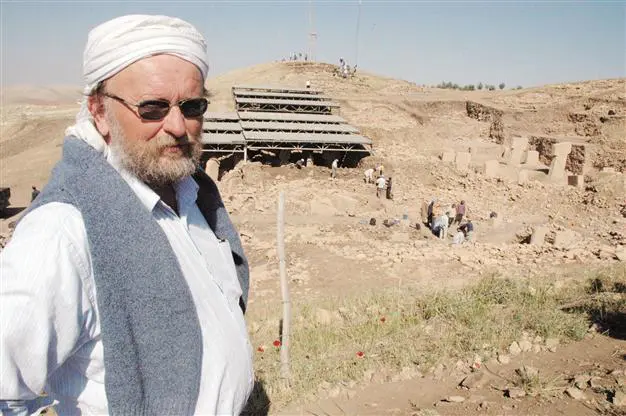
Image of Klaus Schmidt at Gobeki Tepe furnished courtesy of Hurriyet Daily New’s website.
A number of stone pillars found at both sites feature images of various animals that were carved into the stone. What is noteworthy about these images carved into the stone at both sites is the absence of any domesticated animals. The images at both Gobekle Tepe and Karahan Tepe do not include any images of common food animals from that time and place, and this absence is quite odd because animals commonly sourced for food figure so prominently in cave paintings elsewhere from that same time period. While deer, gazelle, and rabbits are featured in the stone carvings at both archeological sites, it is more aggressive non-food animals such as snakes, lions, spiders, and scorpions that seem to get the most attention. Of special note, there is a room at Karahan Tepe which features 11 large stone penises along with a larger-than-life stone serpent with a human face. Interestingly, depictions of humans are scarce at both sites, although some researchers have theorized that the T-shaped pillars represent stylized human or divine figures.
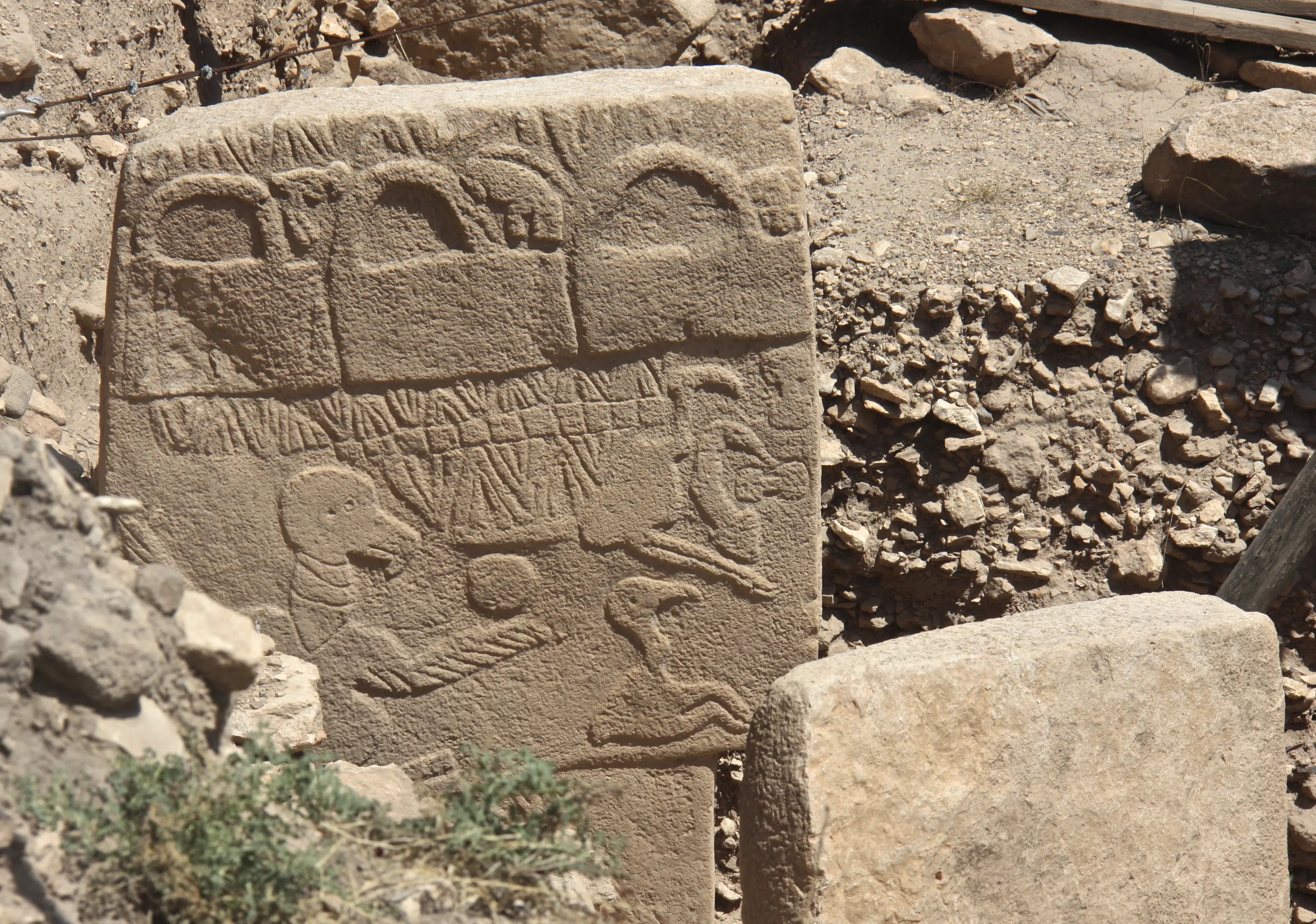
Image of Gabekli Tepe stone carvings furnished courtesy of worldhistory.org
Other than the snake with a human head, divinities are absent from both dig sites to an even greater degree than their human demi-peers. Aside from the images carved into the T-shaped pillars, no depictions of divine beings are in evidence anywhere else at either of these archeological sites. In this connection, the original Anunna pantheon of nearby Sumeria consisted of nameless, and largely undifferentiated deities. As Julius Evola has intriguingly hinted, before they were personalities, the gods were powers, just as early men were mages and magicians before they were priests.
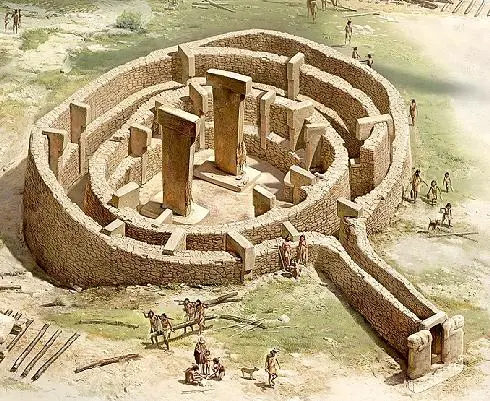
Image of Gobekli Tepe pillars furnished courtesy of tf.uni-keil.de
Gobekli Tepe and Karahan Tepe are archaeologically interesting locations; none the less, both of these sites still seem to represent two dry-as-dust digs in a region that is fairly replete with ancient archeological sites anyway. Gobekli Tepe has been reliably dated to about 10,000 B.C.E, and Karahan Tepe’s oldest excavated strata dates back to 12,000 B.C.E., and researchers on-site at both digs are confident that lower levels will prove to be “much older.” The extreme antiquity of both sites indicates that hunter-gatherers were organizing in numbers sufficient to rear megalithic temples of no little technical and architectural sophistication at least one thousand years before agriculture or animal husbandry had developed to any real degree.
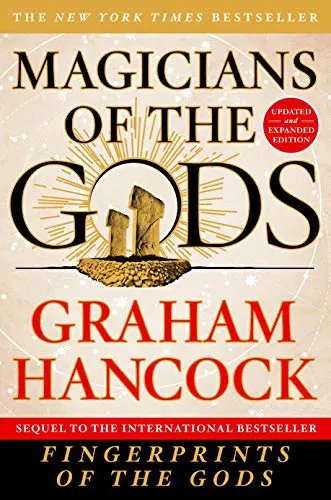
In 2015, Graham Hancock released a sequel to his outstanding and best-selling 1995 book titled Fingerprints of the Gods. Magicians of the Gods is Hancock’s sequel to Fingerprints of the Gods, except this second book is more focused on Gobekli Tepe than the first book in this series. If you have not read Fingerprints of the God, then we recommend that you do so immediately because this book is just such a cool read and such superlative eye-opener! Cover image from Magicians of the Gods furnished courtesy of amazon.com
At Gobekli Tepe and Karahan Tepe, both temples are exactly what these unearthed structures seem to be because there is little evidence of any ongoing human habitation at either location. No bone piles or trash pits have ever been unearthed at either site, yet stone arrowheads and stone blades have been discovered, which suggests that the owners of these old artifacts lived by hunting and not by farming. Yet, for some reason, the people who built both of these megalithic stone structures still found time to erect huge stones for no apparent “practical” purpose.

As of today, the ongoing excavations of Gobekli Tepe are happening under a nice covering and tourists are able to watch the work in progress. Image courtesy of Adobe stock images.

Photo courtesy of Adobe Stock Images.
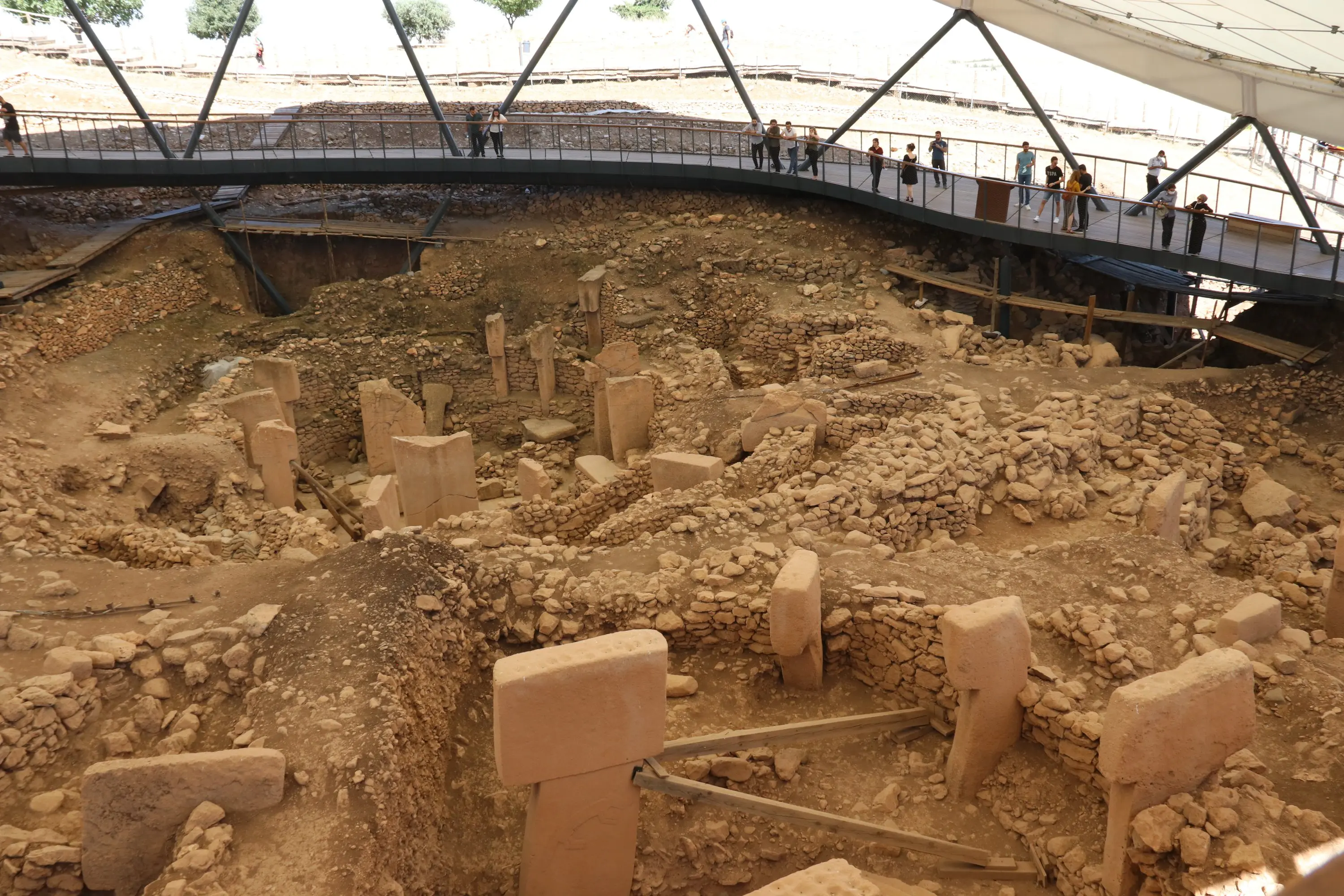
Image of present-day Gobekli Tepe archeological site furnished courtesy of dailysabah.com
The construction of these stone megaliths at the Tepes sites seem to have happened over long intervals because evidence indicates that these circular stone structures were abandoned or even purposely back-filled with dirt while new stone circles were under construction such as what seemed to happen at Karahan Tepe. These construction processes seemed to be quite laborious needless to say. All of the construction at both sites was done in defiance of supposed “necessity,” especially considering that even in lusher prehistory, Anatolia was a moderately arid savannah. As the famous Spanish philosopher Jose Ortega y Gasset notes, in his book Meditations on Hunting, “In prehistoric times, scarcity of game was a fact of life.”

Image courtesy of quickmeme.com
The implications of temple building at Gobekli Tepe and Karahan Tepe are notable because they rewrite our collective understanding of human history. Ian Hodder of Stanford University declared, “Gobekli Tepe changes everything.” Klaus Schmidt puts the matter more precisely: “Before the city there came the temple.”
For we Traditionalists in general, and for National Socialists in particular, the prospects unearthed at Gobekli Tepe and Karahan Tepe verge on dazzling because mainstream science is gaining a model of human history that upends the standard anthropological model which has dominated the world of academia over the past few centuries. Jewish Capitalists and their Marxist cousins have always assumed that humanity is essentially based upon an “economic man,” or “mensches” to use a different word.

Image above furnished courtesy of themenschonabech.com Mensch on a Bench is a line of Hannukkah toys created to to compete with the Elf on a Shelf Christmas toys.

Mensch on the Bench is meant to be a competitor to Elf on the Shelf. Image of Elf on the Shelf seen above is furnished courtesy of tasteofhome.com

The Jews already have their very-own inspirational elf, so was making Mensch on a Bench necessary? Candy Smalls is the animated elf character from the movie Santa Inc. that was voiced by Jewish comedian Sarah Silverman. It seems that international Jewry now truly has their own Elf on a Shelf. Image of Candy Smalls furnished courtesy of boundingintocomics.com

A “mensch” can be understood as an ambulatory belly with gonads grafted on that is motivated by nothing more than immediate rewards, avoidance of pain, and pursuit of pleasure. In this, the creatures who we refer to as “mensches” are responsive and reactive, but not creative. Mensches are thusly defined by their environments, which means that mensches are really nothing more than a somewhat more responsive form of the primordial mud that the creator of our universe worked with at the beginning of time. Mensches are also fundamentally deracinated beings that cooperate (or not) based solely on considerations of perceived utility.

Mensches are also commonly referred to as “bugmen” – you know the type. Image furnished courtesy of knowyourmeme.com
By contrast, the builders of the twin Tepes sites seem to have operated along decidedly different lines of being which stood in stark defiance to notions of simple material “necessity,” which means that the builders of both Tepes invested considerable effort in raising edifices that did not serve the belly or the genitalia. While we will probably never replicate or even understand the patterns of thought, emotions, or volitions of those who built the Tepes, we can still harvest a key lesson from the physical remains of their work.
The first and greatest lesson we can learn from the excavations of the Tepes is that men who create are not simple products of their environment. In a moderately inhospitable environment, the builders of the Tepes showed themselves to be more than simple mesches. In a perfectly literal sense, the builders of the Tepes inverted Maslow’s Pyramid of Needs and did so for a prolonged period of time. For those who are not familiar with Maslow’s Hierarchy of Needs, this theory was originally postulated by the renown psychologist named (((Abraham Maslow))). Maslow’s theory states that people have a hierarchy of needs with basic needs such as getting enough food and having adequate shelter from the elements sitting at the bottom and more sophisticated drives such as artistic expression sitting at the top of the hierarchy ladder. So, Maslow’s theory postulates that people are not going to be overly concerned with making art if they are struggling to survive on a day-to-day basis, yet the story of the Tepes seems to refute Maslow’s most popular idea.

Image of Abraham Maslow courtesy of verywellmind.com
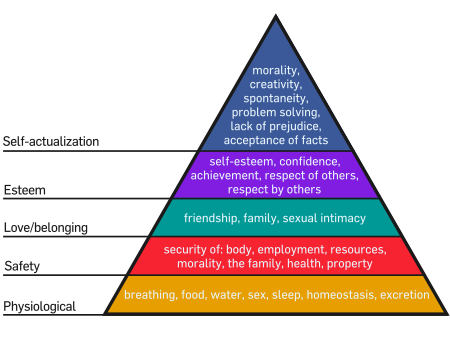
Image of Maslow’s Hierarchy of Needs furnished courtesy of wikipedia.org
For National Socialists and Thuleans, the stories of Gobekli Tepe and Karahan Tepe offer hope and inspiration for navigating today’s trying times because the builders of Gobekle Tepe prioritized spiritual principles over basic survival, yet they still seemed to live and prosper despite devoting so much energy to seemingly non-essential pursuits; therefore, we can do the same thing today by prioritizing the sublime over the worldly and continuing to live. In our times, cultural Marxism — to give the “woke” creed its name — is the dominant cultural force in Western nations; therefore, we face an environment that could be thought of as unforgiving and hostile, just as the Pleistocene period was challenging for early man.
Speaking of Tepes…

Image courtesy of hearthworks.co.uk
Today’s National Socialists and Thuleans might wear social ostracism as a perverse badge of honor; none the less, the Jewish cult of “Cancel Culture” still poses real material threats. For example, at this time, anyone who is publicly known as a National Socialist can pretty much bid farewell to a mainstream career. And, as Trudeau’s Canada shows, expressing even downright anodyne dissent to Canada’s current regime will lead to being denied access to a basic bank account. Those who built the Tepes took a risk by daring to build grand temples despite their challenges of day-to-day living, by contrast, today’s National Socialists are threatened by the Jewish Marxist establishment for creating far more modest works that stand in opposition to the Jewish Menschocracy.

Image of the Thule Society logo furnished courtesy of wikipedia.org
Under present conditions, the edifices we raise are not primarily physical creations but philosophical monuments, and we must raise our philosophical monuments with the same spirit as that of the men who built the Tepes. Like the builders of the Tepes, we must also become men of stone. Humanity has been primarily reduced to mensches, yet we are mages!

Image of wizard costume furnished courtesy of Amazon.com
